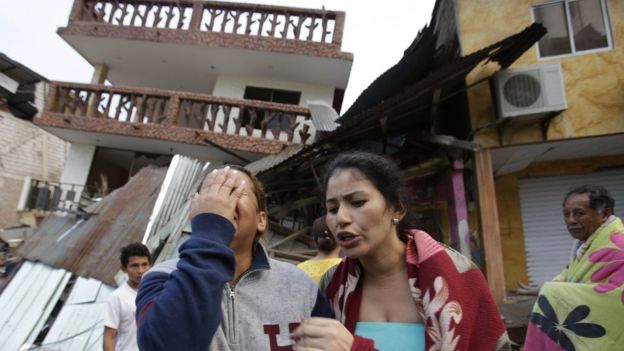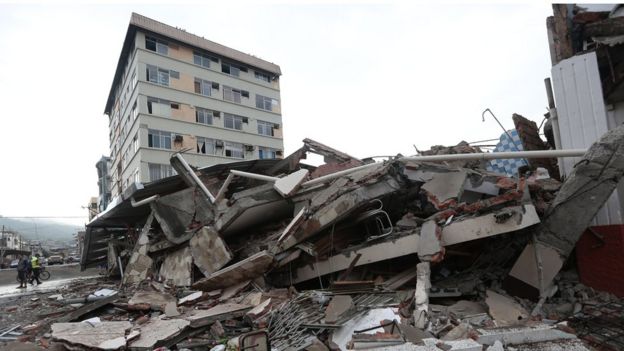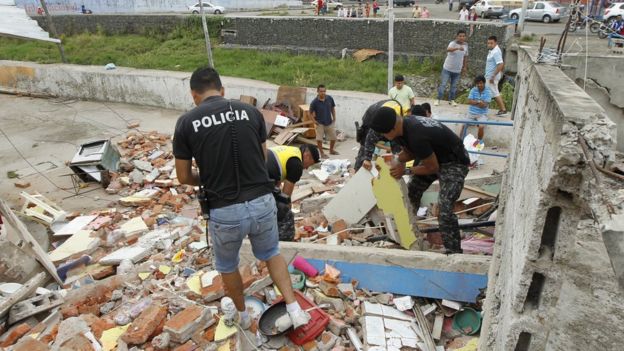Ecuador earthquake: Death toll rises to 233
- 11 minutes ago
- Latin America & Caribbean
At least 233 people have been confirmed dead after Ecuador was hit by its most powerful earthquake in decades.
Some 10,000 troops and 3,500 police are being deployed in the affected areas, as rescue operations got under way.
The magnitude-7.8 quake struck early on Saturday evening and was felt as far away as neighbouring Colombia.
Coastal areas in the north-west were closest to the epicentre and officials say the death toll is likely to rise as information begins to come in.
Ecuador's President Rafael Correa gave the latest death toll on his twitter feedwhile flying back from a visit to Italy he cut short to deal with the disaster.
He has declared a state of emergency and earlier called on his country to be "calm and united"
- In pictures: Ecuador earthquake
- Ecuador quake - your stories
- History of deadly earthquakes
- Can quakes be predicted?
"These are very difficult moments," Ecuador's Vice-President Jorge Glas said.
"We have information that there are injured people who are trapped [under rubble] in different districts and we are getting ready to rescue them."
Helicopters and buses are ferrying troops north but have been hampered by landslides.
In some areas people are using their bare hands to try to dig out survivors.
Food and other essentials has been handed out and international aid was also beginning, with the first coming from Venezuela and Mexico.

At least 500 people were injured in the quake, which was felt across the country.
Widespread severe damage is reported, with a bridge destroyed as far south as Guayaquil about 300km (190 miles) away.
Gabriel Alcivar, mayor of Pedernales, close to the epicentre, said the "entire town" had been flattened.
"We're trying to do the most we can but there's almost nothing we can do," he added, warning that looting had broken out.
 AP
AP AFP
AFP AFP
AFP Reuters
Reuters
In badly hit Manta, one woman said: "The third floor collapsed on top of us.
"They are all there, my family, my sister, my children. They are all there, there are a lot of people. My God, may the help arrive."
Cristian Ibarra Santillan was in the capital Quito when the quake struck.
"There had been some small tremors going on for about two or three months and I thought it was one of those but after about 20, 30 seconds it started to get really strong," he told the BBC.
"And I grabbed my dog and I hid under the table. But then I realised that it wasn't going away so I just ran with him outside."
The quake is Ecuador's largest since 1979. More than 130 aftershocks have followed.
The US Geological Survey said the earthquake struck at a fairly shallow depth of 19.2km (11.9 miles), about 27km from Muisne in a sparsely populated area.
David Rothery, a professor of geosciences at The Open University, said Ecuador's quake was about six times as powerful as the earthquake that struck southern Japan on Saturday.
The quake was also felt in Colombia, where patients in a clinic in the city of Cali were evacuated from the building.
Analysis: Jonathan Amos, BBC science correspondent
Ecuador is well used to earthquakes. There have been seven magnitude-7.0 or greater events within 250km of this latest tremor since 1900. And some of these have resulted in very considerable loss of life, not just from the shaking but also from tsunami waves.
The country sits on the so-called "Ring of Fire" - the arc of high seismic activity that extends right around the Pacific basin. At its location, Ecuador fronts the boundary between the Nazca and South American tectonic plates.
These are vast slabs of the Earth's surface that grind past each other at a rate of about 65mm per year. The Nazca plate, which makes up the Pacific Ocean floor in this region, is being pulled down (subducted) and under the South American coast.
It is a process that has helped build the Andes and Ecuador's many volcanoes, including the mighty Chimborazo.
Models that try to forecast the likely casualty numbers from the nature of the quake and local building construction methods indicate this event could be very serious, with the number of deaths running into the hundreds.

No hay comentarios:
Publicar un comentario